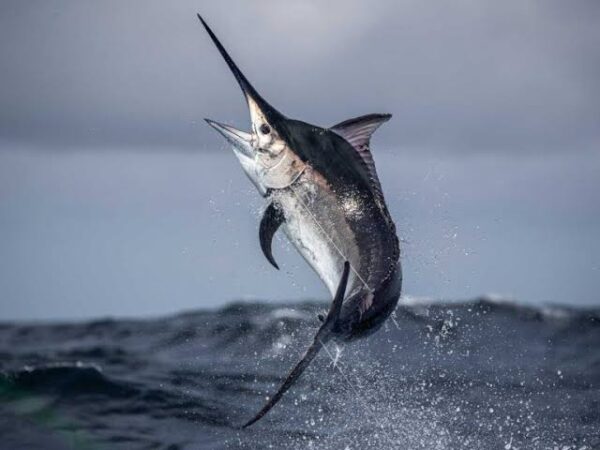 When it comes to speed in the aquatic world, few creatures command as much admiration and awe as the black marlin (Istiompax indica). This powerful and sleek apex predator is widely considered to be the fastest fish in the ocean, capable of reaching burst speeds of up to 82 miles per hour (132 kilometers per hour) according to some reports. While precise speed measurements in the ocean are difficult, multiple scientific and anecdotal observations place the black marlin at the top of the list.
When it comes to speed in the aquatic world, few creatures command as much admiration and awe as the black marlin (Istiompax indica). This powerful and sleek apex predator is widely considered to be the fastest fish in the ocean, capable of reaching burst speeds of up to 82 miles per hour (132 kilometers per hour) according to some reports. While precise speed measurements in the ocean are difficult, multiple scientific and anecdotal observations place the black marlin at the top of the list.
Physical Characteristics
The black marlin is a member of the billfish family, which includes other speedsters like sailfish and swordfish. It is easily recognizable by its:
- Stout, rigid pectoral fins that do not retract, unlike those of its relatives
- Long, spear-like upper jaw (bill), used to slash through schools of fish
- Hydrodynamic body optimized for cutting through water with minimal resistance
- Powerful caudal (tail) fin, which acts like a high-performance propeller
These features make it a highly efficient predator, built for speed and endurance over long distances.
Habitat and Range
Black marlins are typically found in warm waters of the Indo-Pacific region, including the coasts of Australia, Southeast Asia, and the Indian Ocean. They are pelagic, meaning they roam the open seas rather than staying near the coast or the sea floor.
They thrive in waters ranging from the surface to depths of about 300 meters, and their range often overlaps with that of tuna, another fast and powerful swimmer.
Hunting and Feeding
Black marlins feed primarily on smaller fish and squid, including:
- Mackerel
- Tuna
- Trevallies
- Cephalopods
They use their incredible speed and agility to dart into schools of prey, often slashing with their bills to stun or injure multiple fish at once before circling back to consume them. This hunting strategy is not only effective but also dramatically showcases the marlin�s speed and precision.
Speed in Perspective
While it�s difficult to measure exact speeds in the wild, researchers and anglers have observed marlins pulling fishing line off reels at extremely high velocities. Based on calculations from drag resistance and line payout, speeds up to 82 mph (132 km/h) have been reported.
However, some scientists believe a more conservative estimate would be around 50-60 mph (80-97 km/h) in short bursts. Regardless of the debate, even the lowest estimates keep the black marlin at the pinnacle of oceanic speed.
Other Fast Fish: Close Contenders
Though the black marlin often takes the top spot, it isn�t the only aquatic speedster. Here are a few other fish known for their velocity:
1. Sailfish (Istiophorus platypterus)
- Reported speeds: Up to 68 mph (110 km/h)
- Known for its large, sail-like dorsal fin and elongated body
- Can outmaneuver prey with tight turns and swift directional changes
2.�Swordfish (Xiphias gladius)
- Estimated speeds: Around 60 mph (97 km/h)
- Possesses a flat, sword-like bill used for hunting
- Adapted for deep-sea high-speed chases
3. Wahoo (Acanthocybium solandri)
- Top speed: Approximately 48 mph (77 km/h)
- Highly sought-after game fish known for its quick, darting bursts
- Has a slim, torpedo-like body ideal for fast swimming
4.�
Tuna (especially the Yellowfin and�Bluefin species)
- Speeds: Up to 46 mph (74 km/h)
- Among the few fish capable of endothermy (maintaining body temperature)
- Possess immense stamina, allowing them to chase prey across vast distances
Why Are These Fish So Fast?
Several adaptations contribute to the incredible speed of these pelagic predators:
- Streamlined Body: Designed to reduce drag and allow for swift passage through water.
- Muscle Composition: High levels of red muscle allow for sustained swimming, while white muscle delivers explosive bursts.
- Lunate Tail Fin: Crescent-shaped tails generate powerful propulsion with minimal energy loss.
- Efficient Respiration: Some species, like tuna, are obligate ram ventilators, needing to swim constantly to breathe�so speed is a necessity.
Conservation and Human Impact
Like many top predators, the black marlin and its high-speed cousins face threats from overfishing, climate change, and habitat degradation. They are especially vulnerable due to their slow reproductive rates and large ranges. The black marlin is often targeted by sport fisheries, though many areas enforce catch-and-release regulations to help preserve their populations.
Efforts by organizations like the International Game Fish Association (IGFA) and various marine conservation groups aim to promote sustainable fishing practices and protect these incredible animals.
The black marlin stands as a testament to evolutionary engineering, blending speed, power, and elegance in a way that few other marine animals can match. Whether pursued by game fishers or studied by marine biologists, it remains one of the most awe-inspiring creatures in the ocean.
From the marlin slicing through blue waters to the sailfish leaping in bursts of speed, the high-performance world of fast fish reminds us of the extraordinary life that thrives beneath the waves�where the race for survival is won by the swift.







